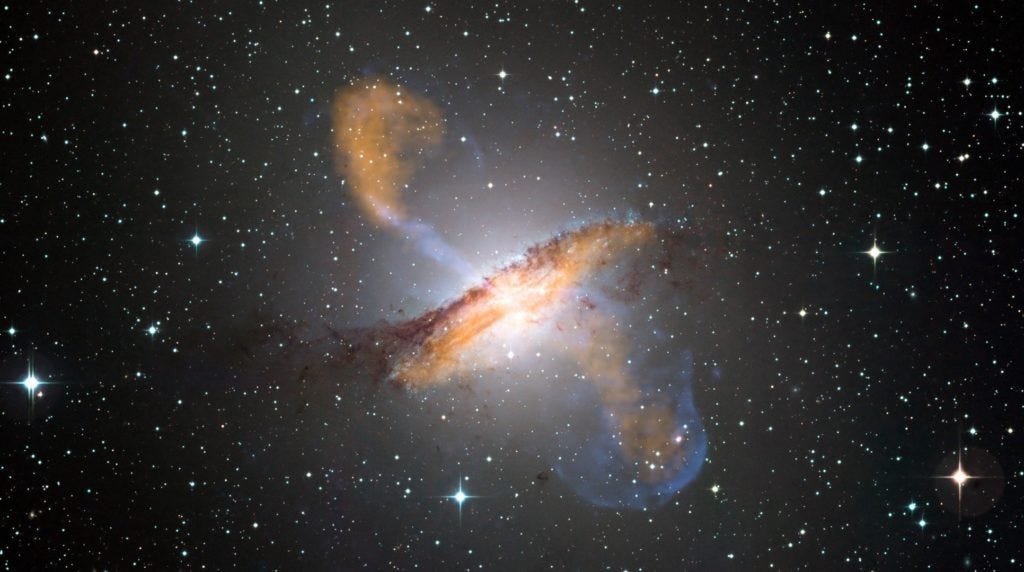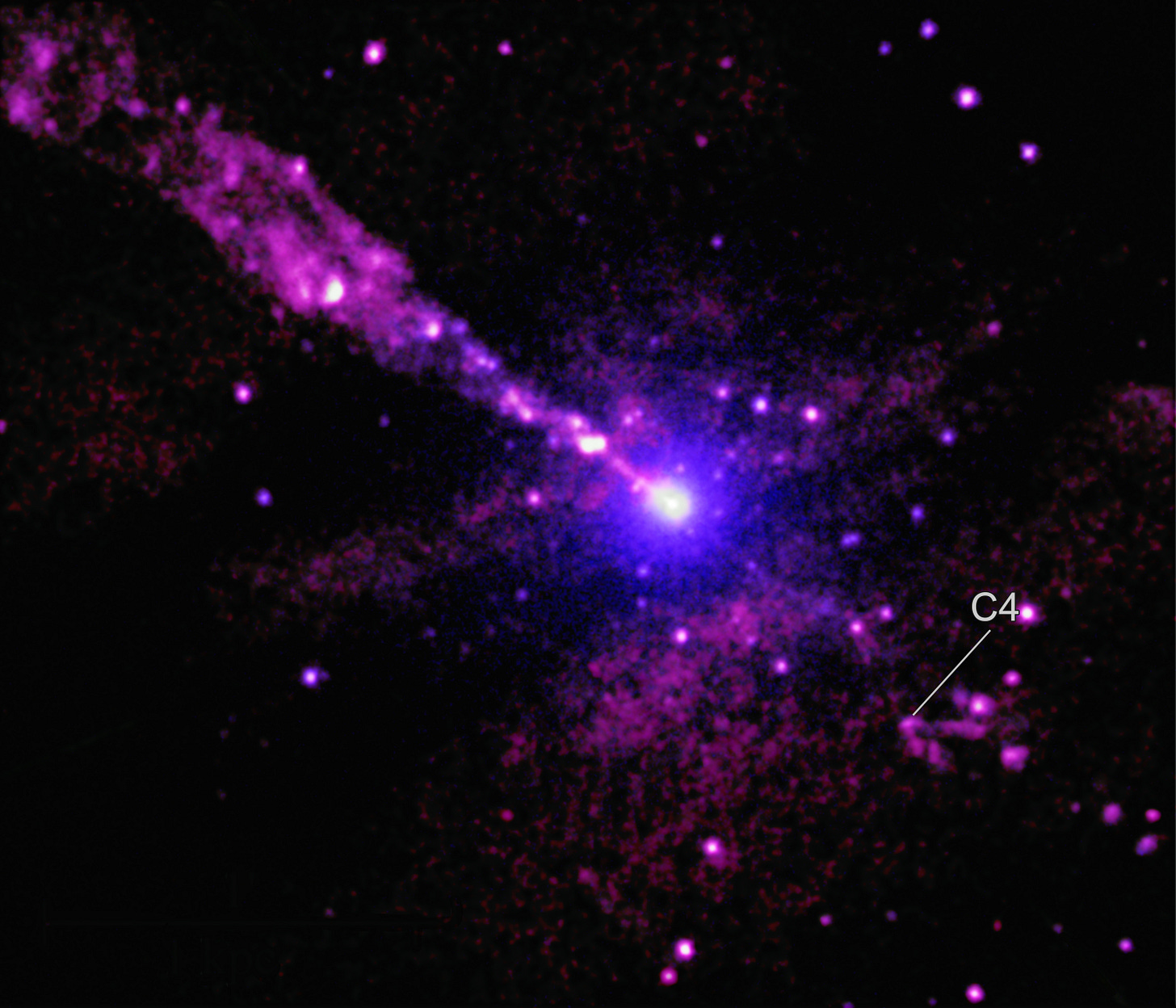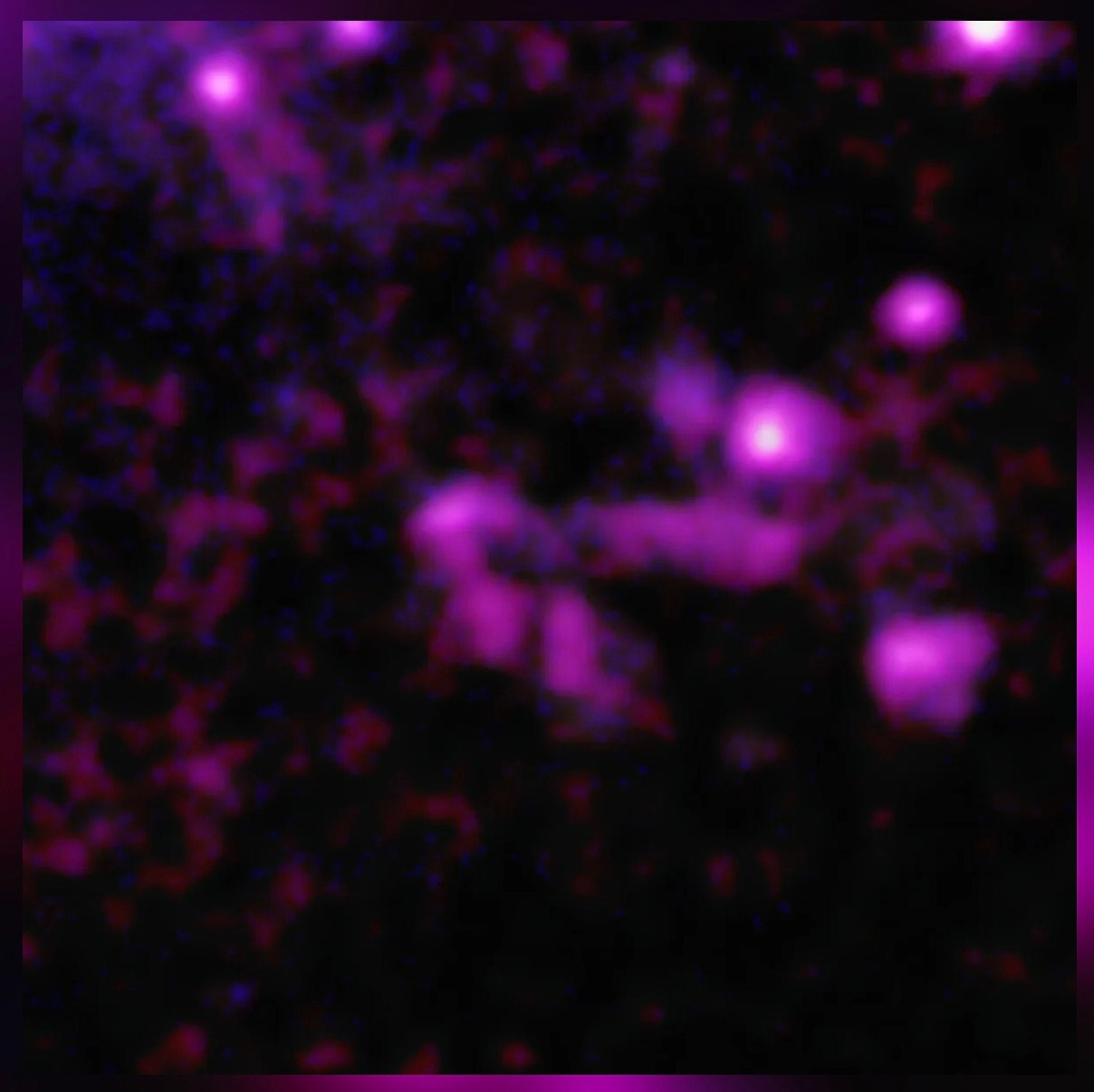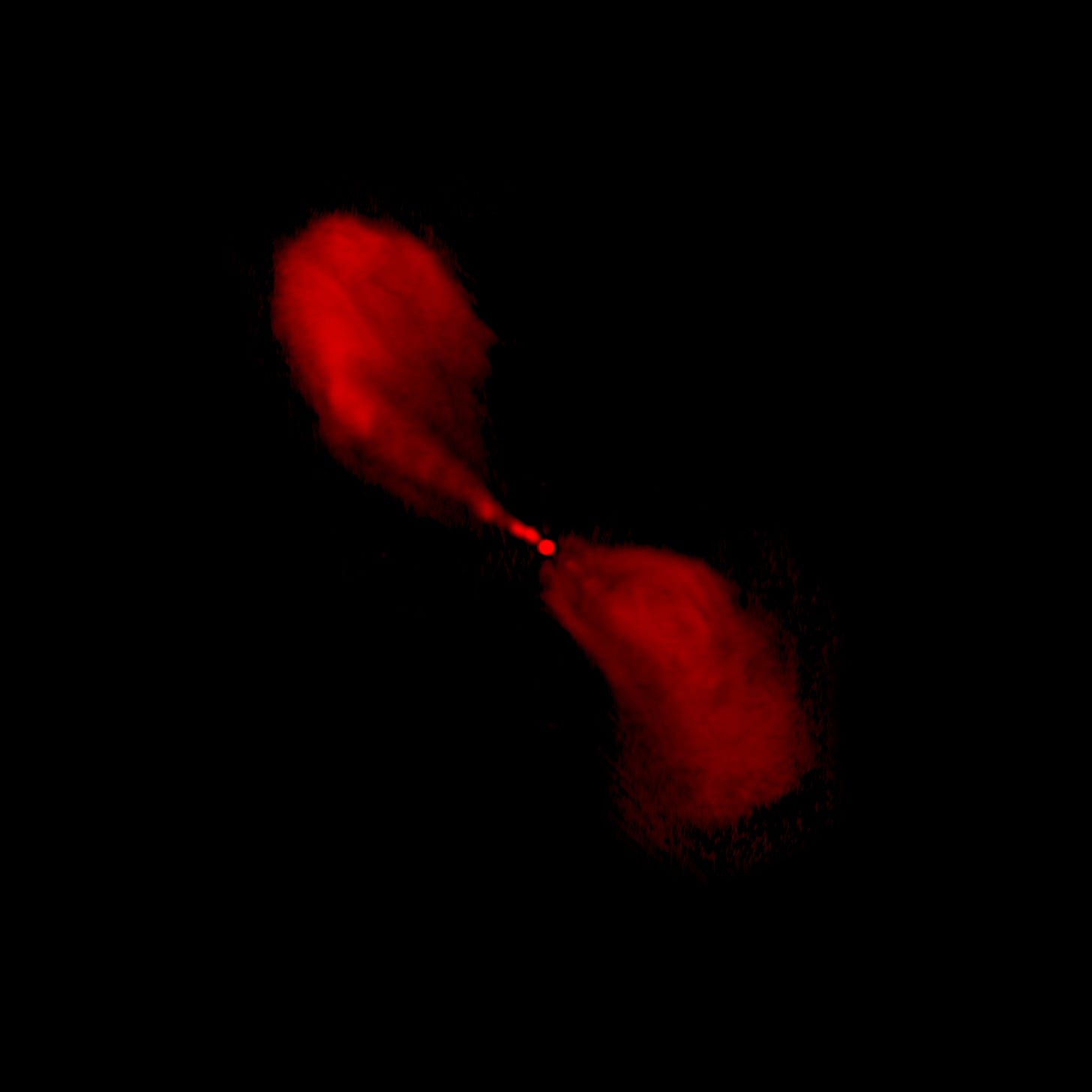Black Hole Jet Blast Blocked by Something
What in the Heavens Could C4 in Centaurus-A Actually Be?
From NASA comes a fascinating report of an unknown object that appears to have blocked the incredibly powerful jet emanating from the black hole at the center of the peculiar elliptical galaxy, Centaurus A. Located about 10 million light-years from earth, Centaurus A is considered the closest active galaxy to earth.
The active part of Centaurus A is driven by an enormous black hole, estimated to be about 55 million times the mass of our sun, at its center. These jets are composed mainly of electrons and ionized matter, mostly hydrogen and helium plasma, ejected from the magnetic poles of the black hole.
As matter in the surrounding accretion disk spirals in toward the black hole, the elements bump into other matter and gets heated to hundreds of millions of degrees centigrade. A fraction of the material does not fall into the black hole, but is ejected from the region around the black hole at its north and south magnetic poles. These are the jets and can accelerate matter to near the speed of light.
In the case of Centaurus A, one arm of the jet — the South Pole as charted from earth — is at the top of the photo above. It extends 33,000 light years into space. And as it blasted its way through the galaxy, some thing NASA terms as a “mysterious, incognito object” stood in its way.
Called Centaurus A C4, C4 for short, the object blocking the jet was detected by the Chandra Space Telescope, an instrument designed to observe X-rays and the extreme high-energy part of the electromagnetic spectrum.
The V-shaped C4 emits X-ray radiation, a sign of having undergone bombardment from the high-energy jets. Other objects seen in the jets’ blast show visual evidence of being affected, but do not emit sufficient X-ray radiation to be imaged by Chandra.
Pure speculation on my part, but perhaps C4 is signs of an artificial structure built by an alien civilization to block the power generated by the plasma jets barreling toward their world. While we don’t yet know, there is much more to study and learn.
Centaurus A imaged in X-ray wavelengths by the Chandra Space Telescope. Credit: NASA/CXC/SAO/D. Bogensberger et al; Image Processing: NASA/CXC/SAO/N. Wolk;
Black Hole Jet Stumbles Into Something in the Dark
by Lee Mohon
NASA, December 10, 2024Even matter ejected by black holes can run into objects in the dark. Using NASA’s Chandra X-ray Observatory, astronomers have found an unusual mark from a giant black hole’s powerful jet striking an unidentified object in its path.
The discovery was made in a galaxy called Centaurus A (Cen A), located about 12 million light-years from Earth. Astronomers have long studied Cen A because it has a supermassive black hole in its center sending out spectacular jets that stretch out across the entire galaxy. The black hole launches this jet of high-energy particles not from inside the black hole, but from intense gravitational and magnetic fields around it.
The image shows low-energy X-rays seen by Chandra represented in pink, medium-energy X-rays in purple, and the highest-energy X-rays in blue.
In this latest study, researchers determined that the jet is — at least in certain spots — moving at close to the speed of light. Using the deepest X-ray image ever made of Cen A, they also found a patch of V-shaped emission connected to a bright source of X-rays, something that had not been seen before in this galaxy.
Called C4, this source is located close to the path of the jet from the supermassive black hole and is highlighted in the inset. The arms of the “V” are at least about 700 light-years long. For context, the nearest star to Earth is about 4 light-years away.
The anomalous object C4 in the Centaurus A galaxy. The V-shaped arms trailing behind C4 are about 700 light years long. Credit: NASA/CXC/SAO/D. Bogensberger et al; Image Processing: NASA/CXC/SAO/N. Wolk;
While the researchers have ideas about what is happening, the identity of the object being blasted is a mystery because it is too distant for its details to be seen, even in images from the current most powerful telescopes.
The incognito object being rammed may be a massive star, either by itself or with a companion star. The X-rays from C4 could be caused by the collision between the particles in the jet and the gas in a wind blowing away from the star. This collision can generate turbulence, causing a rise in the density of the gas in the jet. This, in turn, ignites the X-ray emission seen with Chandra.
The shape of the “V,” however, is not completely understood. The stream of X-rays trailing behind the source in the bottom arm of the “V” is roughly parallel to the jet, matching the picture of turbulence causing enhanced X-ray emission behind an obstacle in the path of the jet. The other arm of the “V” is harder to explain because it has a large angle to the jet, and astronomers are unsure what could explain that.
This is not the first time astronomers have seen a black hole jet running into other objects in Cen A. There are several other examples where a jet appears to be striking objects — possibly massive stars or gas clouds. However, C4 stands out from these by having the V-shape in X-rays, while other obstacles in the jet’s path produce elliptical blobs in the X-ray image. Chandra is the only X-ray observatory capable of seeing this feature. Astronomers are trying to determine why C4 has this different post-contact appearance, but it could be related to the type of object that the jet is striking or how directly the jet is striking it.
A paper describing these results appears in a recent issue of The Astrophysical Journal. The authors of the study are David Bogensberger (University of Michigan), Jon M. Miller (University of Michigan), Richard Mushotsky (University of Maryland), Niel Brandt (Penn State University), Elias Kammoun (University of Toulouse, France), Abderahmen Zogbhi (University of Maryland), and Ehud Behar (Israel Institute of Technology).
NASA’s Marshall Space Flight Center in Huntsville, Alabama, manages the Chandra program. The Smithsonian Astrophysical Observatory’s Chandra X-ray Center controls science operations from Cambridge, Massachusetts, and flight operations from Burlington, Massachusetts.
Read more from NASA’s Chandra X-ray Observatory.
Learn more about the Chandra X-ray Observatory and its mission here:
Centaurus A close-up, detailing C4 at center above. Astronomers wonder how it's V-shaped wake was turned relative to the direction of the black hole jet. Note the other V-shaped object at top of frame has both “tails” in its V roughly parallel to the jet’s direction. Perhaps the discrepancy in C4’s tail is due to parallax as viewed from earth or gravitational pull from the black hole jet as it swung through and by. Credit: NASA/CXC/SAO/D. Bogensberger et al; Image Processing: NASA/CXC/SAO/N. Wolk;
Visual Description
This release features a series of images focusing on a collision between a jet of matter blasting out of a distant black hole, and a mysterious, incognito object.
At the center of the primary image is a bright white dot, encircled by a hazy purple blue ring tinged with neon blue. This is the black hole at the heart of the galaxy called Centaurus A. Shooting out of the black hole is a stream of ejected matter. This stream, or jet, shoots in two opposite directions. It shoots toward us, widening as it reaches our upper left, and away from us, growing thinner and more faint as it recedes toward the lower right. In the primary image, the jet resembles a trail of hot pink smoke. Other pockets of granular, hot pink gas can be found throughout the image. Here, pink represents low energy X-rays observed by Chandra, purple represents medium energy X-rays, and blue represents high energy X-rays.
Near our lower right, where the jet is at its thinnest, is a distinct pink “V”, its arms opening toward our lower right. This mark is understood to be the result of the jet striking an unidentified object that lay in its path. A labeled version of the image highlights this region, and names the point of the V-shape, the incognito object, C4. A wide view version of the image is composited with optical data.
At the distance of Cen A, the arms of the V-shape appear rather small. In fact, each arm is at least 700 light-years long. The jet itself is 30,000 light-years long. For context, the nearest star to the Sun is about 4 light-years away.\
Source NASA: Black Hole Jet Stumbles Into Something In the Dark.
Centaurus A in radio wavelengths. One can see evidence for the black hole’s rotation from the ends of the jets, which seem to leave a trail of plasma behind as the jets turn, spun by the rotation of the massive black hole at the galactic center. Credit: NRAO/AUI/NSF/Univ.Hertfordshire/M.Hardcastle
Like the rotating beacon of a cosmic lighthouse, the jets blasting from the black hole at the heart of Centaurus A form a beam of electrons and ionized atoms, perhaps a half-light day across, to speeds near the speed of light, a relativistic ray gun that destroys most everything in its path. The jets extend about 33,000 lights years from the center of the galaxy.
Notice the nature of the jets in the radio-spectrum image above. The bright white circle at the center depicts the general area of the black hole. The slightly less bright dots to the left may be instances of large clumps of in-falling matter. Perhaps the cataclysmic moments when they fell in to the black hole are reflected in the uneven, puffy “spokes” that appear in the trailing edge at the end of the top jet.
Going by humanity’s love for the sky, I think other species with eyes would likewise look up and be inspired by the heavens. And I believe it likely that ancient alien astronomers near the path of an approaching jet would see it coming.
A Stop Sign in the Heavens?
Physicist Dr. Freeman Dyson, PhD in his 1960 paper, “Search for Artificial Stellar Sources of Infrared Radiation,” proposed that advances in astronomy may one day detect signs of other advanced civilizations in the form of artificial structures built around stars. Encircling its home star, a civilization constructing a “Dyson Sphere” would harness much of the electromagnetic radiation given off by the star, energy an advanced alien civilization could use to sustain its well being.
Perhaps C4 is signs of an advanced alien construction program. Rather than harnessing a sun’s power, however, the goal was to build a shield to block a home world and star system from the the plasma jet as it turned toward their world. If so, C4 might have deflected its destructive power to save its home world.
It’s pure speculation on my part, but whatever stood up to the black hole jet must be either incredibly dense and massive or incredibly strong or both. We don’t know — yet — going from the impressive close-up image from the Chandra Space Telescope above, perhaps C4 was part of a multi-part line of defense meant to protect a world from certain annihilation.
“Don’t Let This Happen to Your Planet”
About 97-percent of the matter in the universe that we can detect is in the form of hydrogen, followed by helium, produced when two hydrogen nuclei fuse to create one helium nucleus in the nuclear reactions that drive stars.
Astronomers consider any element heavier than helium to be “metals,” marking how truly rare are carbon, nitrogen, oxygen and the other elements all the way to and past uranium — traces of which have been discovered in the vastness of space and the interiors of stars.
Nevertheless, the elements for life and many of the complex organic molecules that life requires have been found in throughout our solar system and detected in interstellar space. Perhaps the conditions of life are universal. Going from where humanity has visited or probed, so far only earth has been found to harbor life.
What the mysterious object C4 can be, however, is at present a mystery. And while we don’t know what that is or how it worked on the jet, it makes a darn good spot to study. Who knows? There might be somebody sending us an SOS or showing us how to protect ourselves from a danger that can literally destroy a world and most anything else in its way. If a warning, I’d wager it would be: “Don’t let this happen to you.”







